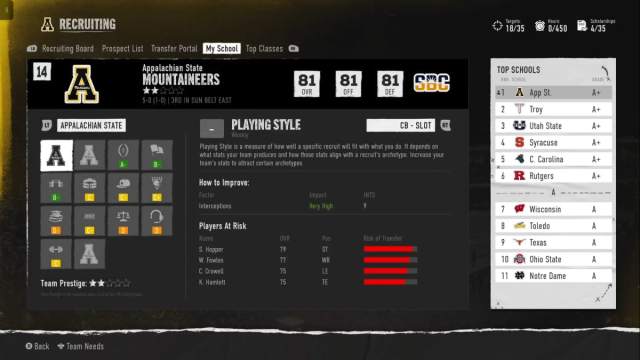College Football 25 Dynasty players have plenty to focus on during their careers, including balancing the Playing Style rating to reduce the risk of transfers—and we’ve got some tips on how to adjust.
Although recruiting is one of the most valuable skills in College Football 25, keeping the core of your team intact for as long as possible is also vital, and failing to meet a player’s preferred Playing Style increases the risk of transfers and will also impact your recruitment strategy.
If you’ve got players at risk of transfer and you want to fix it, we can tell you how to boost your Playing Style rating in College Football 25.
How to improve Playing Style rating in CFB 25

Your Playing Style rating in College Football 25 is based on your in-game stats and varies for each player archetype, so you may need to prioritize improvements in specific areas to prevent a star player from leaving.
For example, Rushing Yards Per Game needs to be improved for a running back to stay, while Passing Yards are required for quarterbacks—and there are plenty of other stats that affect your Playing Style rating too.
If you’re struggling to improve your rating, increase the length of quarters in games to give yourself more opportunities to make plays and improve your stats, especially if you’re playing with very short quarters.
As mentioned before, each player archetype is tied to different requirements for Playing Style. To make things easier, we’ve compiled this information in the table below showing all the specific stats you may need to improve and the positions they impact.
| Stat | Positions | Archetypes |
| Passing Yards Per Game | Quarterback Half Back Wide Receiver | QB – Field General QB – Improviser QB- Scrambler |
| Rushing Yards Per Game | Half Back Full Back Tight End Center Offensive Tackle Guard | HB – Power Back HB – Elusive Back FB – Blocking FB – Utility TE – Blocking C – Power C – Agile OT – Power OT – Agile G – Power G – Agile |
| Receiving Yards Per Game | Half Back Wide Receiver | HB – Receiving Back WR – Deep Threat WR – Route Runner WR – Physical TE – Vertical Threat TE – Possession |
| Sacks Allowed | Center Offensive Tackle Guard | C – Pass Protector OT – Pass Protector G – Pass Protector |
| Sacks | Defensive End Defensive Tackle Outside Linebacker | DE – Speed Rusher DE – Power Rusher DT – Speed Rusher DT – Power Rusher OLB – Power Rusher |
| Tackles For Loss | Defensive End Defensive Tackle Outside Linebacker Middle Linebacker Safety | DE – Run Stopper DT – Run Stopper OLB – Run Stopper MLB – Field General MLB – Run Stopper S – Run Support |
| Interceptions | Outside Linebacker Middle Linebacker Cornerback Safety | OLB – Pass Coverage MLB – Pass Coverage CB – Man To Man CB – Slot CB – Zone S – Zone S – Hybrid |
| Field Goals Made | Kicker Punter | KP – Accurate |
| Field Goals Longest | Kicker Punter | KP – Power |












Published: Jul 23, 2024 9:31 AM UTC